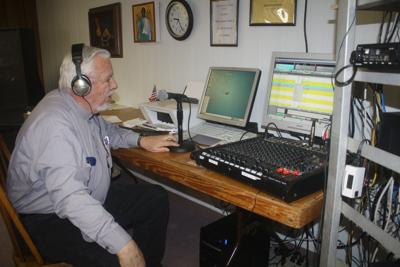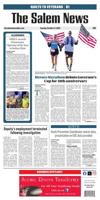Sacred Heart Catholic Church has been broadcasting live on 96.5 FM KSOZ, which stands for “King and Savior of the Ozarks” since Jan. 14. At 8:30 a.m. on Sunday morning, listeners can tune in for a half hour of music, followed by Mass at 9 a.m. The idea for the station had been kicking around in Father Dan Hirtz’s mind since 2001.
“A number of years ago we began investigating the possibilities,” said Hirtz. “What more can we do to share or get the Good News out into the public? And along with that, recognizing that we have, right now, 18 church members who are homebound. So how can we also get the services into their homes?”
A few years ago, the government opened up additional low-power FM licenses. Shortly after, the church decided to take to the airwaves. That was two years ago, when a firm decision was made by the church to make the radio station a reality.
“It’s low power, and that’s what made it appealing,” said Hirtz. “It was reasonable, and also allows us to easily cover the territory we have.”
According to Hirtz, the radio station has a 10-mile radius, which the church is grateful for.
“We thought we’d only be able to get 5 or 6 miles, but it goes 10-plus.” said Hirtz. “We’re happy with that … it was better than we anticipated.”
Deacon Richard Cole, president of KSOZ, cites an even further range, given ideal conditions.
“I can – in my yard at my house – actually pick it up, and I’m 18 miles out,” says Cole. “We can get it almost to Rolla, depending on the weather.”
Cole says that the low-power FMs like the church uses are 100-watt stations. According to Cole, the federal communications board is considering bumping such stations up to 250 watts in the future.
The station runs off of a computer in the basement of the rectory, next to a rack of various electronic bells, whistles and Father Dan’s upright standing casket, which, rumor has it, he made himself (and/or possibly for Halloween). An old car radio is used to pick up FM signals. “Hey, use what you got,” quips Cole, laughing. “Make it work.”
The setup was greatly helped by the skills of college student Jonathon Barton, who took care of a few of the more knowledge-intensive tasks, like installing Linux on one of the machines, instead of Windows, for stability purposes.
“He’s been invaluable,” said Hirtz.
Programming is handled by a program called Simian. It’s set up to make sure all of the radio slots are filled. The programming, for now, consists mostly of EWTN (Eternal Word Television Network), a Catholic station that Cole says is one of the biggest networks in the world.
“They’re huge,” says Cole. “Multiple languages… we’ve been over and visited their studios, and they’re huge. They do most of the programming.”
The station is starting to break in live every now and then, though. Cole shows how he can cut into the feed live at any time.
“We had two funerals over the weekend, and before each funeral, I manually went here (points to a cord on the mixing board), turned that off, then turned on my microphone and announced that we were saying goodbye to some good friends and parishioners,” said Cole. “Try to do a little eulogy.”
The church just started broadcasting its own Mass a couple weeks ago.
“I wasn’t sure we were ready,” Cole laughs. “But we went ahead and did it anyway, and it did very well.”
As for the future of the radio station, Hirtz and Cole are thinking up new ways to spread the message.
“We're hoping to do more and more of our own programming and use other sources as well that are more appropriate for the area,” says Cole. “But most of what you’re coming across is pretty darn appropriate.”
The Sacred Heart congregation, about 450 members strong, will surely agree.















